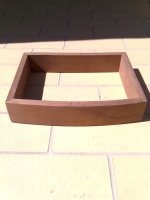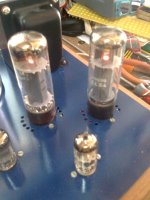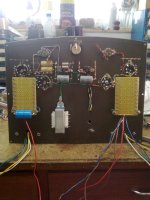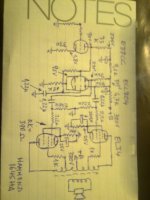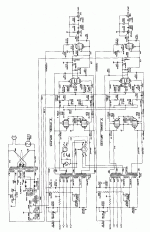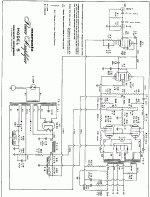Well, it is a newbie project,but i am not very happy with the sound ,it seems doesnt have enough power, but i will post the schematic to get your opinion about it, maybe i havesome mistake in there!
Thank you for your comments
EL156
Thank you for your comments
EL156
30W o/p with a pair of EL34's should be a breeze. Using 92dB/w LS sensitivity with good sized bass drivers should rock the room. This was a standard classic design of the 1960's and found amps of this everywhere in halls and theatres.
richy
richy
it seems doesnt have enough power
Do you mean that the sensitivity is low, which means that your input signal can not give full output ?
Or do you mean that the output signal becomes distorted before the sufficient sound level is achieved ?
Can you show the chematic ?
Do you mean that the sensitivity is low, which means that your input signal can not give full output ?
Or do you mean that the output signal becomes distorted before the sufficient sound level is achieved ?
Can you show the chematic ?
I think sensitivity is ok , the signal comes distorted before sufficient sound level is achieved, I have to draw the schematic first to post it later on or tpmorrow.
EL156
EL34
Fair circuit so should work ok. I note there is no negative feedback so speaker impedance will have a big impact on the frequency respose (as per a typical guitar amp/combo) and matching the speaker impedance to the reflected output impedance will cosiderably affect power output. As a general rule you should load a typical 8ohm speaker to a 4 to 6 ohm tap to account for speaker impedance dips.
With the 380 volt supply I wouldn't expect much more than around 20 watts.
Here's another note for any other builders of ultralinear EL34 designs, you should never exceed a max of 420 for the HT, otherwise you will get flashovers between the screen grid and control grid, very nasty.
Incidentally this is my first posting on this site.
Fair circuit so should work ok. I note there is no negative feedback so speaker impedance will have a big impact on the frequency respose (as per a typical guitar amp/combo) and matching the speaker impedance to the reflected output impedance will cosiderably affect power output. As a general rule you should load a typical 8ohm speaker to a 4 to 6 ohm tap to account for speaker impedance dips.
With the 380 volt supply I wouldn't expect much more than around 20 watts.
Here's another note for any other builders of ultralinear EL34 designs, you should never exceed a max of 420 for the HT, otherwise you will get flashovers between the screen grid and control grid, very nasty.
Incidentally this is my first posting on this site.
Apply output global feedback from the output of the output transformer back to the 1st stage 330 resister. Try 22k and 100p in the feed back loop. You will loose a little gain, but it will be far better behaved. I prefer fixed bias in the outputs... but then even the Marantz 5 an 7 use global feedback .
Attachments
Thanks
I Will test the amp with fixed bias, i have an extra 30 Vac in the power transfo,so it will be easy to do !
But do you think the operating points of the tubes in the schematic are okay?
EL156
I Will test the amp with fixed bias, i have an extra 30 Vac in the power transfo,so it will be easy to do !
But do you think the operating points of the tubes in the schematic are okay?
EL156
All seems to be OK, especially if the DC-volgaes on the schematic are measured and real values from your amplifier. Are those ?
To locate possible fault in the circuit you should have an oscilloscope.
Concerning the design: There do not seem to be any negative feedback used. This would essentially lower the distortion, improve frequency response, but also lower the sensitivity.
However, even without feedback you should get some 25 Watts output power at least.
To locate possible fault in the circuit you should have an oscilloscope.
Concerning the design: There do not seem to be any negative feedback used. This would essentially lower the distortion, improve frequency response, but also lower the sensitivity.
However, even without feedback you should get some 25 Watts output power at least.
Yes! All the voltages are exactly as shown in schematic,and i dont use feedback,because i prefer the sound without it, but i say i ddont have enough power, because i have a EL84 PP ,wich seems to have about the same power as this one, and of course i know this a logaritmic relation in the power difference(twice power,you dont have twice sound pressure in your ears).All seems to be OK, especially if the DC-volgaes on the schematic are measured and real values from your amplifier. Are those ?
To locate possible fault in the circuit you should have an oscilloscope.
Concerning the design: There do not seem to be any negative feedback used. This would essentially lower the distortion, improve frequency response, but also lower the sensitivity.
However, even without feedback you should get some 25 Watts output power at least.
But i will make some tests with feedback
Thanks
EL156
i dont use feedback,because i prefer the sound without it
I understood that you have not heard how it sounds with feedback yet ??
No ! No feedback yet ,but i will make tests and see what happens !I have a 20 Mhz Scope ,but i dont have signal generator to make more tests ! I think i only can use the 1 Khz square wave from the scope.I understood that you have not heard how it sounds with feedback yet ??
EL156
Thank you , and WELLCOME to the forum!Fair circuit so should work ok. I note there is no negative feedback so speaker impedance will have a big impact on the frequency respose (as per a typical guitar amp/combo !) and matching the speaker impedance to the reflected output impedance will cosiderably affect power output. As a general rule you should load a typical 8ohm speaker to a 4 to 6 ohm tap to account for speaker impedance dips.
With the 380 volt supply I wouldn't expect much more than around 20 watts.
Here's another note for any other builders of ultralinear EL34 designs, you should never exceed a max of 420 for the HT, otherwise you will get flashovers between the screen grid and control grid, very nasty.
Incidentally this is my first posting on this site.
el156 --The Hammond 1645 has a 5000 ohm plate-to-plate primary, which -- when operating in UL mode -- is too low for EL34s operating with cathode bias. Distortion will be significantly elevated, and power output will be reduced. Your options include staying with cathode bias but converting to true pentode operation, or for even better performance, stay in UL mode, but convert to fixed bias operation.
As for appropriate B+ levels, I must respectfully disagree with the previous poster, in that as long as there are screen stability resistors in place (which your design includes), B+ levels on the screen as high as 450 volts with fixed bias operation is no problem for EL34 tubes. Screen arcing problems at this voltage level are virtually always caused by operating the tubes with fixed bias, and supplying the screen grids from a very low impedance power source. The use of screen stability resistors of at least 100 ohms eliminates this concern.
Operating the tubes with fixed bias and a stable 450 volt B+ supply, will produce over 40 watts RMS on the secondary, which will exceed the limits of the Hammond 1645, since it is a 30 watt transformer. With a stable 380 volts B+ you indicate on your schematic, the amplifier will develop just over 30 watts RMS when operating with fixed bias. If you elect to retain cathode bias and convert to true pentode operation, you can expect 25 watts RMS at a B+ of 380 volts. Of course if your B+ supply sags under increased power output conditions, power output will suffer accordingly.
Dave
As for appropriate B+ levels, I must respectfully disagree with the previous poster, in that as long as there are screen stability resistors in place (which your design includes), B+ levels on the screen as high as 450 volts with fixed bias operation is no problem for EL34 tubes. Screen arcing problems at this voltage level are virtually always caused by operating the tubes with fixed bias, and supplying the screen grids from a very low impedance power source. The use of screen stability resistors of at least 100 ohms eliminates this concern.
Operating the tubes with fixed bias and a stable 450 volt B+ supply, will produce over 40 watts RMS on the secondary, which will exceed the limits of the Hammond 1645, since it is a 30 watt transformer. With a stable 380 volts B+ you indicate on your schematic, the amplifier will develop just over 30 watts RMS when operating with fixed bias. If you elect to retain cathode bias and convert to true pentode operation, you can expect 25 watts RMS at a B+ of 380 volts. Of course if your B+ supply sags under increased power output conditions, power output will suffer accordingly.
Dave
but i dont have signal generator to make more tests !
There are plenty of free programs available at the net to make your pc souncard to generate test signals. (sine,square,saw,triangle)
Please see:
TrueRTA Audio Spectrum Analyzer Download Page
Audacity: Free Audio Editor and Recorder
The Hammond 1645 has a 5000 ohm plate-to-plate primary, which -- when operating in UL mode -- is too low for EL34s operating with cathode bias.
I see that the 5000 ohms load impedance is at optimum level, when calculating from used anode voltage and -current. Also the data from Mullard EL34 confirms this.
In addition, UL-connection is very insensitive to load impedance and can feed vearious loads with low distortion (compared to pentode).
- Status
- Not open for further replies.
- Home
- Amplifiers
- Tubes / Valves
- EL34 PP PROJECT
